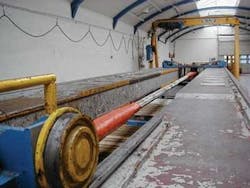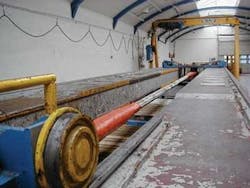New standard polyester rope test method
Vidar Åhjem, Det Norsk Veritas
John Flory, Tension Technology International
Det Norske Veritas (DNV) and Tension Technology International (TTI) are now conducting research to develop a better understanding of the change-in-length properties of large polyester ropes and to develop a standardized test method that can efficiently measure these properties. This research is part of a joint industry project sponsored by oil companies and contractors, with broad support from the rope-making community.
Even though fiber ropes are used commonly and successfully as mooring lines on deepwater production platforms, concern remains regarding their complex stiffness and stretch characteristics. These new testing standards aim to alleviate these concerns.
The mooring system designer will have accurate change-in-length properties available even during preliminary design. Alternate system designs and alternate installation procedures can readily be evaluated.
Mooring line stretch during installation and over the entire mooring service life can be predicted. This mitigates the risk of specifying mooring ropes that are either too long or too short. Peak mooring line tensions can be predicted. This might allow smaller ropes to be used to reduce the cost and risk of installation.
Large polyester fiber ropes are used commonly as mooring lines on deepwater production platforms. Petróleos Brasileiro (Petrobras) pioneered the use of polyester moorings beginning in the mid 1990s, and has installed more than 24 polyester moorings in Brazilian waters. The first permanent production system polyester moorings in the Gulf of Mexico wereMad Dog and Red Hawk, both installed in 2004. Other permanent polyester mooring systems now have been installed in and are being planned for the GoM and other areas of the world. Polyester mooring systems also are used on MODUs.
At first there was apprehension with using polyester ropes in permanent deepwater moorings. But years of successful service and extensive research conducted by TTI and others, have demonstrated that polyester rope mooring lines do not degrade due to tension, cyclic tensioning, or sea water.
Change-in-length
Despite success with fiber rope, one concern remains – the complex stiffness and stretch characteristics of polyester rope.
Rope stiffness and permanent stretch are important factors in deepwater mooring system design. Mooring system designers are familiar with the linear stiffness coefficients of wire rope, which are easy to define and do not vary with time. Also, permanent stretch of wire rope is not significant. However, it has been difficult to quantify the stiffness of a polyester mooring line in service. The stiffness is generally nonlinear. It depends on the rate of tensioning and on the rate of cyclic tensioning.
Polyester ropes also experience significant permanent stretch. Stiffness affects maximum mooring line tensions and thus requires rope break strength. Permanent stretch affects line length during installation and, thus, requires rope length. Stiffness and stretch both influence maximum mooring line length during extreme events and, therefore, affect maximum platform offset and required riser or drillstring length.
Early designers of polyester mooring systems relied on the results of only a few tests to define these change-in-length parameters and tried to extrapolate from these to specific applications.
Several published standards and guidelines for deepwater fiber rope mooring system design guidelines recommended specific test sequences. These were intended to represent a typical mooring system installation process and subsequent peak loading incidents. The problem is that the results of such tests generally have been inadequate for the design of specific mooring systems.
As a result, now mooring system designers specify custom test sequences intended to represent the anticipated installation process and peak loading incidents for a specific application. These custom tests are costly and time consuming, and demanding for rope manufacturers if necessary for each bidding process.
Understanding rope properties
Examination of results from many polyester rope change-in-length tests has lead to an understanding that the important properties can be represented by four basic parameters represented by a simple spring and dashpot model.
The model comprises four units in series:
- A dashpot unit to represent polymer creep
- A parallel spring and ratchet unit to represent rope construction stretch
- A parallel spring and dashpot unit to represent slow response to tension
- A separate spring unit to represent fast response to tension.
The dashpot, representing polymer creep, stretches rapidly at first, but the rate of stretch soon diminishes. For polyester, this coefficient can be plotted as a straight line against log time. After a few days under tension, additional creep is generally insignificant.
The parallel spring and ratchet unit represents rope construction stretch – the rearrangement, realignment, and compaction of strands and yarns that occurs when tension is applied to the rope. This construction stretch is semi-permanent. Most of it occurs the first time the rope is tensioned to a given load. The rope structure then remains set in that condition, unless the rope is completely relaxed and flexed.
The fast spring represents the stretch that occurs immediately as the rope is tensioned rapidly. It immediately retracts when tension is relieved.
The slow spring and dashpot unit represent stretch over time, either when the rope is slowly tensioned or when tension is maintained on the rope. It slowly retracts when tension is relieved from the rope.
When polyester rope is subjected to cyclic tension, it stiffens. The combination of the fast spring and the slow spring-dashpot units models this apparently peculiar phenomenon.
Spring-dashpot represents change-in-length
The spring-dashpot model is intended to represent and to help understand the complex change-in-length properties of polyester and other fiber ropes. Although it appears to be an analog model, analog computer techniques are not needed to model rope properties.
The change-in-length properties are in the form of coefficients, similar to elastic modulus, which can be used in hand calculations or digital computer calculations.
The present JIP addresses only polyester ropes. The spring-dashpot model probably can be applied to or adapted for other fiber materials of interest in deepwater mooring systems.
It will be possible to determine the coefficients of each of these units through a short, simple sequence of tests. The testing should take less than the week or more required to carry out the extensive test programs specified today.
It will only be necessary to run the sequence of tests once to determine the change-in length properties for any particular rope design. The rope manufacturer will be expected to conduct these tests and to publish the results and make them available upon request to mooring system designers.
Coefficients can be used
With these coefficients, the mooring system designer can predict the change-in-length properties of the rope after any loading history and in response to any load change. It will not be necessary to carry out custom tests for each deepwater mooring system design.
During preliminary mooring system design, the required mooring line length and required take-up can be calculated based on an assumed installation procedure. If the installation procedure changes during design, the calculation can be rerun without retesting the rope.
Peak mooring tensions and maximum mooring line stretches, which occur in response to different extreme events such as hurricanes or loop currents, can be calculated readily using the basic change-in-length properties. This will be much more effective and efficient than running a rope test for only one or several extreme events.
Using the basic polymer creep and construction stretch properties of the rope, the total permanent stretch over the service life of the mooring can be predicted accurately. The required length take-up then can be determined.
Standard method advantages
The large polyester ropes used in deepwater moorings consist of a number of subropes arranged in parallel and held together by a braided jacket. In some cases, the full rope consists of a fixed number of subropes, for example seven, and the subrope size is then scaled up to increase strength. In other cases, the size of the subrope is constant and more subropes are bundled together to increase strength. In either case, the properties of the full rope can be determined from sub-rope testing. Testing sub-ropes not only will be more economical, but also will be more accurate.
Generally, it will be necessary for a rope manufacturer to conduct the change-in-length tests only once on a particular subrope design. When bidding a particular project, the manufacturer will not be required to conduct custom testing to determine change-in-length. The manufacturers will not need to cover the cost of custom testing in their bids.
In summary, by applying the proposed methods of defining and testing for change-in-length properties of large mooring ropes, the overall cost of the mooring system can be reduced by:
- Testing subropes, which is less costly and more accurate than full rope testing
- Using a “standardized” test method that provides data applicable for any installation or service situation
- Not requiring potential rope manufacturer bidders to conduct custom tests when bidding
- Having accurate rope change-in-length data at the beginning of the design process.
Implementation of new test
The JIP sponsors have the preliminary results of the study and will receive a final report describing the proposed spring-dashpot test method for change-in-length properties in mid-2008. New sponsors can still join the project and gain from the results at this time. However, the results of the project must otherwise remain confidential until 2011.
The new test method will be released as part of a new edition of the DNV Offshore Standard DNV-OS-E303 “Certification of Fiber Ropes for Offshore Mooring” in 2011. Before then, an internal, fully updated version will be issued to the JIP sponsors, so that they can begin using and benefiting from this new method immediately.
About the authors
Vidar Åhjem is a principal engineer in his 16th year at DNV. He took part in the testing and qualification of the earliest fiber mooring systems some 10 years ago and has been working in this field ever since.
John Flory is president of Tension Technology International LLC. He is a mechanical engineer with an advanced degree in engineering mechanics. He has extensive experience in research, development, design, and application of mooring systems and associated components.




